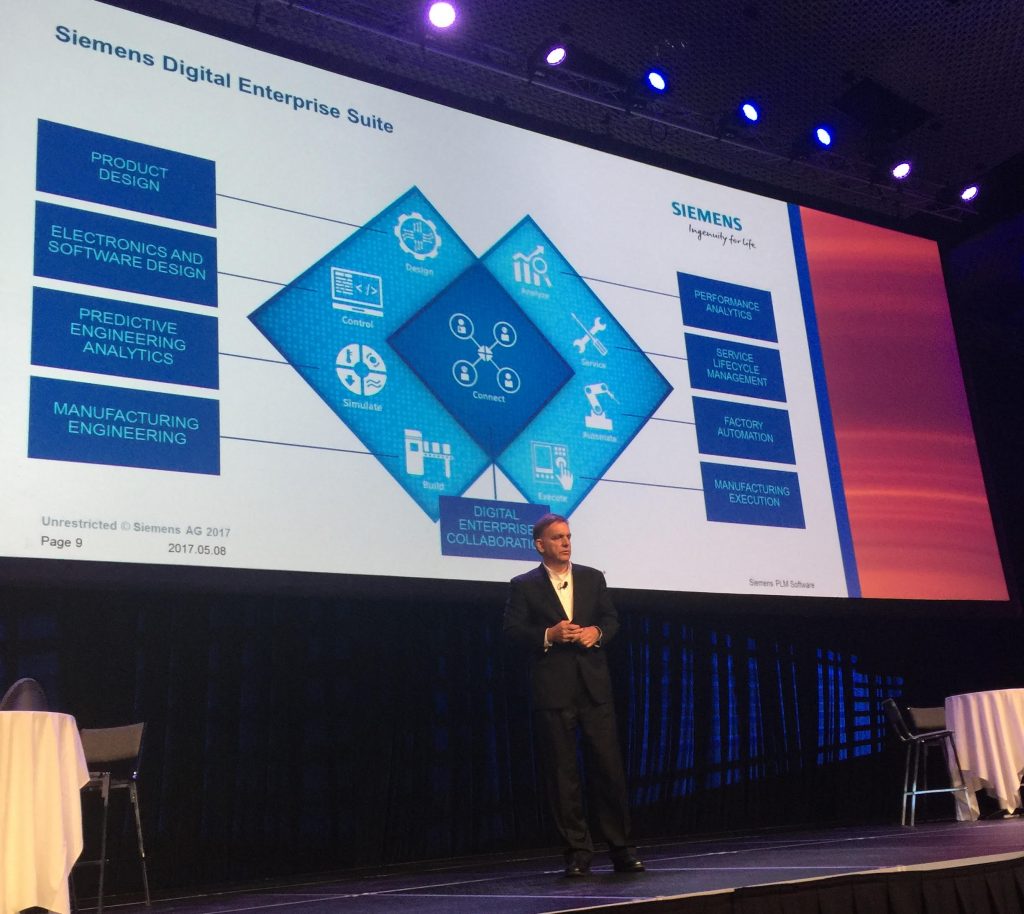
Tony Hemmelgarn, president and CEO of Siemens PLM Software
Latest News
May 17, 2017
The race is on to allow companies to take advantage of the digital transformation disrupting business today, such as access to virtually unlimited computing power to crunch all of the Big Data available from the industrial Internet of Things (IoT), or the mass customization and new business opportunities that knowledge can enable thanks to intelligently automated manufacturing processes and predictive maintenance. The winners of the race may well be determined by who can put all of those buzzwords together in the most complete virtual process (the longest digital thread) that most closely resembles the real world (the most identical digital twin). In less buzz-worthy parlance, companies need to address both scope and fidelity when adopting new workflows.
 Tony Hemmelgarn, president and CEO of Siemens PLM Software, explains Siemens’ Digital Enterprise Suite at Siemens PLM Connections 2017.
Tony Hemmelgarn, president and CEO of Siemens PLM Software, explains Siemens’ Digital Enterprise Suite at Siemens PLM Connections 2017.At Siemens PLM Connections 2017, which took place in Indianapolis in May, Siemens PLM Software made its case for its approach to digitalization, which reaches far “to the left” of the product development flow, as the company put it, and far to the right into manufacturing, especially when you include its parent company’s Manufacturing Operations Management (MOM) and Totally Integrated Automation (TIA) portfolios. Tony Hemmelgarn, president and CEO of Siemens PLM Software, told attendees that this breadth of solutions, including those from newly acquired Mentor Graphics, allows the company to create a more complete digital twin.
More than a third of #PLMConx 2017 attendees are from the aerospace industry, and almost a fourth are from automotive. pic.twitter.com/3yBbzEma11
— Digital Engineering (@DEeditor) May 8, 2017
“Sometimes the value of the twin is not always so good because the twins aren’t that close to each other,” Hemmelgarn said. “And what we’re seeing in our industry is, I see large manufacturing companies talk about digital twin and, at best, they might be able to represent a little of what’s happening in the factories—no idea how to design the product, no idea how to do the manufacturing execution of the product. Or you see a CAE (computer-aided engineering) company talk about digital twin and the best they can do is analytics on a part, maybe—no idea how to produce it, no idea how to design it. So really, is there a lot of value in that digital twin if it’s setup that way and you’re not really representing the full digital twin of the product?”
He said Siemens has spent $6.5 billion since 2013 to grow out its portfolio to make a more identical digital twin. That doesn’t include the 2012 LMS acquisition, but does include Camstar, CD-adapco, Polarion, Mentor Graphics and others. It is integrating its simulation solutions into a portfolio called Simcenter.
“Together we have an unrivaled digital thread,” said Martin O’Brien, VP of Mentor’s Integrated Electrical Systems Division, from the stage. “We can feed off each other intellectually. We can create best-in-class, open solutions and finally take a real step forward in creating a true model-based enterprise.”
Connecting Virtual and Real Worlds
With all those tools across the spectrum of product design and development, data analysis and manufacturing, it’s easier to understand if they’re categorized. While Hemmelgarn was quick to point out that the company doesn’t silo its products by technology, lifecycle stage or discipline, it does split the stages of digitalization broadly into ideation, realization and utilization sections. In the company’s nomenclature, ideation is the up-front stage of product development and utilization includes the feedback loop of data coming back from the enterprise and products in the field.
“Many people miss the middle part,” Hemmelgarn said. “Somebody’s got to make it and build it. This is where we think the real value of Siemens is. Not only do we cover all three, but we also produce products and we make things. We use our own software to do that, and we learn a lot from doing that.”
To prove that point, Jim Rusk, senior vice president and chief technology officer for Siemens PLM Software, brought Alan Klapmeier, CEO of One Aviation, to the stage to illustrate how his company uses Siemens’ products. The pair then embarked on an example workflow that highlighted the role of Siemens PLM Software tools in realizing the digital twin using One Aviation’s Eclipse 500 VLJ (very light jet) as an example. In the demonstration, various representatives from Siemens PLM Software shared the stage to explain how Siemens’ tools could be used to correct a hypothetical issue with a landing gear door that wasn’t closing correctly.
Siemens’ Bill Lewis and Paul Brown walk #PLMConx attendees thru a smart product development demo on a mechanical landing gear design. pic.twitter.com/XhvTP33HAj
— Digital Engineering (@DEeditor) May 8, 2017
The demonstration was a tangible example of how Siemens envisions its tools will be used in the digital enterprise. Mechanical and electronic design and simulation were involved, as was generative design, software development, simulation, additive manufacturing, sensors, data analysis and augmented reality. All along the way, FAA regulations were taken into account as the process was documented. Though hypothetical, it was an impressive example of the benefits of digitalization that are already available today.
The demonstration was a specific example of steps shown in the Siemens Enterprise Showcase at the Digital Manufacturing and Design Innovation Institute (DMDII) in Chicago. Learn more about it here:
https://youtu.be/YOmh82ZYSZ4
Related:
Subscribe to our FREE magazine, FREE email newsletters or both!
Latest News
About the Author
Jamie Gooch is the former editorial director of Digital Engineering.
Follow DE





